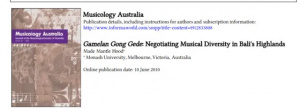
There are several communities in the highlands of Bali in Indonesia that still maintain large antique orchestras of bronze gongs and metallophones called gamelan gong gede. These gamelan have been preserved as essential implements of local ritual-music associations that have protected them from change for generations. In contrast, much of the rest of the island abandoned gong gede in the early twentieth century in favor of modern gamelan. Inseparable from its highland ritual context, gong gede endure in Bali’s remote highlands because they are inseparable from ritual context, which has resulted in musical diversity within the broader ecosystem of Balinese music.
This diversity simultaneously marginalizes communities to some degree from mainstream musical innovation. However, it also empowers local ritual music associations within sophisticated social networks that play a major role in protecting and preserving these ancient antique orchestras. Using a ‘pluralism of musical structures’ as an analytical framework for discussing musical diversity, this article looks at how highland communities protect and maintain gong gede as ‘living traditions’ by examining their history, social context and musical style to see what keeps local traditions from succumbing to mainstream musical trends.






Enable comment auto-refresher